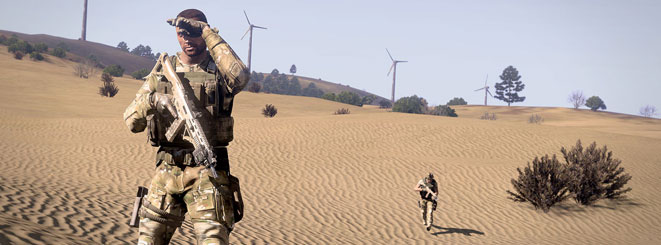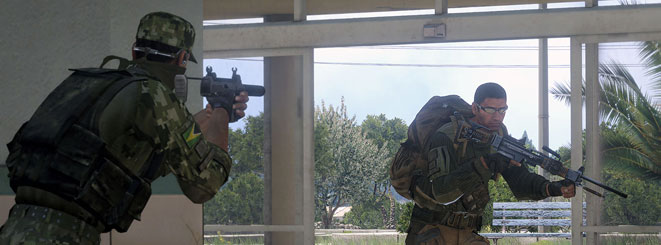UNIT: Radko Voda , Designer, Sandbox Design Dept.
TO: Arma 3 Dev-Branch Users
OPSUM: Feature Refinement: Fatigue & Weapon Sway mechanics.
EVALUATION
Among other hot topics, Fatigue and Weapon Sway have been - and still are - a matter of passionate debate within the both community and our own team. In Arma 3, they're core aspects of gameplay that simulate certain cumulative or rechargeable impediments that players must manage and that, ultimately, determine a player's combat effectiveness.
Over the past few weeks - and with the forthcoming Bootcamp Update in mind - we've tried to find ways to refine these mechanics in an attempt to create even more authentic and challenging gameplay. Now, we'd like to share our design goals and overall progress with you.
THE BEST LAID PLANS
FATIGUE
Currently, fatigue mechanics prevent you from sprinting and holding breath when your level of exhaustion exceeds certain thresholds. This also increases the inherent weapon sway and, thereby, makes it harder for you to aim and shoot accurately. The new mechanics generally work the same way in terms of slowly accumulated impediment, however they bring some great new elements to it. Most importantly, there will be an 'animation slowdown'. This effect builds up according to the fatigue level and causes a player's movements to slow down by a certain non-linear degree.

The actual rate of slowdown varies greatly depending on specific actions and circumstances. Fatigued soldiers will be evidently slower and more cumbersome than well-rested ones. The fatigue level of combatants becomes a major factor in determining the results of an encounter, right next to the individual levels of skill, qualities of equipment and abilities of squad commanders. Managing fatigue becomes more important. It's also useful to note that all fatigue gains are intrinsically multiplicative; negative effects do not just stack, they accumulate like a snowball.
When playing with new fatigue, the main points to bear in mind are:
- Each particular stance you're in has a different influence over fatigue gain or decay.
- Running with a raised weapon produces more fatigue than the same movement with it lowered.
- Running in crouch is more demanding than running while standing, and the same applies for sprinting as well.
- Rifles are obviously heavier than pistols, so movement with them is harder, but not as much as with launchers.
- Walking restores fatigue, but not as much as standing still.
- Reasonable management of your stances and movement options allows you to control your exhaustion and, thus, manage your fatigue at reasonable levels.
- Running in crouch all day long is no longer the best default option to move around.
- Both fatigue gain and decay are affected by the weight of equipment.
- The more loaded down you are, the more fatigue you get from every exhaustive action. Moreover, the less quickly will your fatigue decay while resting.
- A fully loaded soldier can barely rest at all!
- Also bear in mind, that your inventory load has no direct impact upon your actual speed. However, it will cause the actual slowdown to take place much quicker and maintain its effect for much longer.
- Always consider the terrain. Not only for cover, but also for fatigue.
- The greater the slope, the more exhausted you will become by ascending it.
- On the other hand, descending certain convenient slopes could actually restore some of your fatigue as well.
- "the natural formation of the country is the soldier's best ally" - Sun Tzu, Art of War.
WEAPON SWAY
Weapon Sway mechanics represent the inherent movement of a firearm in your hands. While the previous implementation had certain merits, we also felt it contained some important shortcomings. Mainly, we felt that it worked too randomly and unintuitively, crippling any skillful approach. Mechanics that just force you to fight with some randomly generated penalties applied have nothing to do with authenticity.

Instead, we want players to actually understand the game mechanics in order to give them an opportunity to learn and manage their behaviour. Therefore, we refined the sway behaviour to actually simulate breathing and grip as separate forces that affects your weapon sway in a more predictable - and thus manageable - way. This, we hope, enables more meaningful weapon handling. Your grip is not always rock steady. You have to maintain it to be able to place precise shots.
There are three main aspects of weapon sway to consider:
- Breathing moves your aim up & down with a magnitude and speed directly correlated to your current fatigue.
- You may temporarily cancel this inherent movement by holding your breath.
- How long you may hold it depends on the oxygen capacity left in your lungs, which is also affected by Fatigue.
- Be aware that after you start to breath again - or if your oxygen is depleted by holding breath for too long - there will be a temporary spike in the breathing penalty, according to the proportion of oxygen left.
- "Do you think that's air you're breathing now ?" asked Morpheus once. Well, in Arma 3, we do for sure!
- As with fatigue, every stance also affects your aim in some way.
- In general, you are more precise when crouched down than standing, and the most precise when prone.
- Also basic positions (standing, crouch, prone) are slightly more stable when still, but yet more prone to distortion while turning around.
- Adjusted positions are slightly less precise by default, but suffer less penalty from turning around.
- Exhaustion has a detrimental effect upon your sway by producing both inherent sway of your gun and your breath, simulating the hardship of handling a weapon when exhausted.
- Injuries suffered do not affect your breath as much as fatigue, but their effect over your grip are much more profound.
- While fatigue effect over sway is still quite manageable - at least to the point where you cannot hold your breath anymore - the effect of injuries could be potentially very severe for your ability to aim, depending on actual damage distribution over your body parts.
COMBAT READY
That wraps up the basics of the upcoming new Fatigue and Sway mechanics. Hopefully, these explanations will give you a better idea about what to expect and how to handle all these changes. We hope that such improvements will address all those players who asked for more profound mechanics of weapon handling and more demanding fatigue system for quite a long time.
These improvements, and even those already in preparation, are a direct product of your feedback, and its only upon your feedback we may continue to improve it even further! So, tell us if, how, and why, you like it (or not) on our forums. Are some of the effects too severe or too shallow? What other behaviour would you like to see implemented in these mechanics? Every (reasonable!) view matters and we are truly thankful for it, even though we cannot address all of you at once.